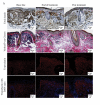Electro-optical Synergy Technique: A New and Effective Nonablative Approach to Skin Aging
- PMID: 21203352
- PMCID: PMC3013553
Electro-optical Synergy Technique: A New and Effective Nonablative Approach to Skin Aging
Abstract
Objectives: Electro-optical synergy technology is one of the most recently described methods for nonablative skin rejuvenation. The aim of this study is to evaluate the effects of electro-optical synergy on connective tissue composition by histological and immunohistochemical techniques coupled with computerized morphometric analysis.
Design: A prospective clinical study.
Participants: Six volunteers with Fitzpatrick skin types 3 to 4 and Glogau class I to II wrinkles were subjected to three months (6 sessions at 2-week intervals) of electro-optical synergy treatment.
Measurements: Standard photographs and skin biopsies were obtained at baseline as well as three and six months after the start of treatment. The authors performed quantitative evaluation of total elastin, tropoelastin, collagen types I, III, and VII, and newly synthesized collagen.
Results: Noticeable clinical and histological improvement was observed after electro-optical synergy treatment. A statistically significant increase in the means of collagen types I, III, and VII, as well as newly synthesized collagen, together with increased levels of tropoelastin, were detected, while the mean level of total elastin was significantly decreased at the end of treatment and three months post-treatment.
Conclusion: Electro-optical synergy is an effective treatment for contouring facial skin laxity. This modality stimulates the repair processes and reverses the clinical, as well as the histopathological, signs of aging with the advantage of being a relatively risk-free procedure with minimal patient recovery time.
Figures








Similar articles
-
Efficacy of mesotherapy in facial rejuvenation: a histological and immunohistochemical evaluation.Int J Dermatol. 2012 Aug;51(8):913-9. doi: 10.1111/j.1365-4632.2011.05184.x. Int J Dermatol. 2012. PMID: 22788806 Free PMC article. Clinical Trial.
-
Effects of the Nd:YAG 1320-nm laser on skin rejuvenation: clinical and histological correlations.J Cosmet Laser Ther. 2011 Jun;13(3):98-106. doi: 10.3109/14764172.2011.586423. J Cosmet Laser Ther. 2011. PMID: 21609211 Clinical Trial.
-
Multiple microneedling sessions for minimally invasive facial rejuvenation: an objective assessment.Int J Dermatol. 2015 Dec;54(12):1361-9. doi: 10.1111/ijd.12761. Epub 2015 Jun 20. Int J Dermatol. 2015. PMID: 26096653
-
Facial tightening with an advanced 4-MHz monopolar radiofrequency device.J Drugs Dermatol. 2012 Nov;11(11):1288-94. J Drugs Dermatol. 2012. PMID: 23135076 Review.
-
Nonsurgical nonablative treatment of aging skin: radiofrequency technologies between aggressive marketing and evidence-based efficacy.Aesthetic Plast Surg. 2009 May;33(3):283-94. doi: 10.1007/s00266-009-9361-9. Epub 2009 May 13. Aesthetic Plast Surg. 2009. PMID: 19437070 Review.
Cited by
-
Efficacy of mesotherapy in facial rejuvenation: a histological and immunohistochemical evaluation.Int J Dermatol. 2012 Aug;51(8):913-9. doi: 10.1111/j.1365-4632.2011.05184.x. Int J Dermatol. 2012. PMID: 22788806 Free PMC article. Clinical Trial.
-
A New Approach with Combined Microneedle and Sublative Fractional Radiofrequency for Photoaging Management: A Clinical, Histometric, and Immunohistochemical Study.Aesthetic Plast Surg. 2025 Mar;49(5):1435-1443. doi: 10.1007/s00266-024-04416-0. Epub 2024 Oct 16. Aesthetic Plast Surg. 2025. PMID: 39414647 Free PMC article.
-
Multiple minimally invasive Erbium: Yttrium Aluminum Garnet laser mini-peels for skin rejuvenation: an objective assessment.J Cosmet Dermatol. 2012 Jun;11(2):122-30. doi: 10.1111/j.1473-2165.2012.00606.x. J Cosmet Dermatol. 2012. PMID: 22672276 Free PMC article.
-
Microneedling Therapy for Atrophic Acne Scars: An Objective Evaluation.J Clin Aesthet Dermatol. 2015 Jul;8(7):36-42. J Clin Aesthet Dermatol. 2015. PMID: 26203319 Free PMC article.
-
Clinical evaluation of the efficacy and safety of combined bipolar radiofrequency and optical energies vs. optical energy alone for the treatment of aging hands.Lasers Med Sci. 2017 Aug;32(6):1387-1392. doi: 10.1007/s10103-017-2257-z. Epub 2017 Jun 23. Lasers Med Sci. 2017. PMID: 28643046 Clinical Trial.
References
-
- Kligman LH, Kligman AM. The nature of photoaging: its prevention and repair. Photodermatol. 1986;3:215–227. - PubMed
-
- El-Domyati M, Attia S, Saleh F, et al. Intrinsic aging vs. photoaging: a comparative histopathological, immuno-histochemical, and ultrastructural study of skin. Exp Dermatol. 2002;11:398–405. - PubMed
-
- Helfrich YR, Sachs DL, Voorhees JJ. Overview of skin aging and photoaging. Dermatol Nurs. 2008;20:177–183. - PubMed
-
- Uitto J. The role of elastin and collagen in cutaneous aging: intrinsic aging versus photoexposure. J Drugs Dermatol. 2008;7:S12–S16. - PubMed
-
- Sadick NS, Weiss R. Intense pulsed-light photorejuvenation. Semin Cutan Med Surg. 2002;21:280–287. - PubMed
Grants and funding
LinkOut - more resources
Full Text Sources
Other Literature Sources
